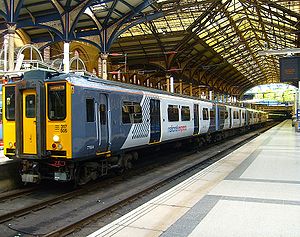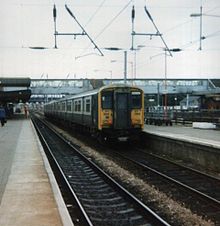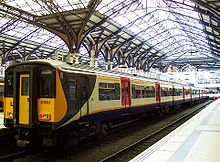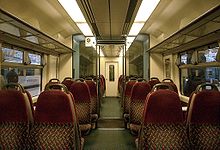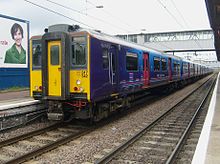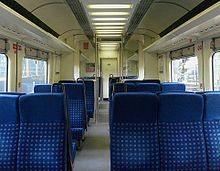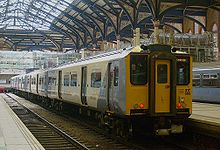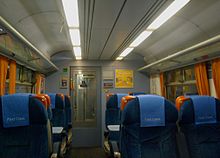- British Rail Class 317
-
British Rail Class 317
A newly repainted National Express East Anglia Class 317/5 No. 317505 at London Liverpool Street
The refreshed interior of a Class 317/5 EMUIn service 1981 - current Manufacturer BREL York Family name BR Second Generation (Mark 3) Constructed 1981 - 1982
1985 - 1987Refurbishment 1998 - 2000
Railcare Wolverton
(317/6 and 317/7 only)Number built 72 trainsets Formation 4 cars per trainset Operator First Capital Connect
National Express East Anglia (including Stansted Express)Specifications Car length 19.83 m (65 ft 1 in) Width 3.70 m (12 ft 2 in) Height 2.82 m (9 ft 3 in) Maximum speed 100 mph (160 km/h) Weight 137.3 tonnes (135.1 long tons; 151.3 short tons) (317/1, 317/2, 317/7)
138.18 tonnes (136.00 long tons; 152.32 short tons) (317/6 only)Power output 746 kW (1,000 hp) Electric system(s) 25 kV AC Overhead Braking system(s) Air (Westinghouse) Gauge 1,435 mm (4 ft 8 1⁄2 in) Standard gauge The British Rail Class 317 alternating current electric multiple units (EMUs) were built by BREL York in two batches, from 1981-82 and 1985-87. They were the first of several classes of British Rail EMU to be based on the all-steel Mark 3 bodyshell, departing from the "PEP"-aluminium design which had spawned the earlier Class 313 to Class 315. The Mark 3 bodyshell was also the basis of Class 318, Class 455, and the diesel Class 150.
Contents
Description
Class 317/1
The first batch of 48 units, built in 1981-82, were classified as Class 317/1. Units were numbered in the range 317301-348, and had a maximum speed of 100 mph. Each unit consisted of four carriages; two outer driving 2nd class only vehicles, an intermediate trailer with both 1st and 2nd class, and a motor vehicle with 2nd class seating, roof mounted Stone Faiveley AMBR pantograph and four GEC G315BZ traction motors. The technical description of the formation of the units is DTSO(A)+MSO+TCO+DTSO(B). Individual carriages were numbered as follows:
- 77000-77047 - DTSO(A)
- 62661-62708 - MSO
- 71577-71624 - TCO
- 77048-77095 - DTSO(B)
These units were built to operate services on the newly electrified London St. Pancras to Bedford "Bed-Pan" route. They replaced the elderly and unreliable Class 127 diesel multiple units. However, they did not enter service immediately due to an industrial dispute with the unions over Driver only operation, and the diesel units lingered on until finally being replaced in mid-1983. Units were delivered in the standard livery of BR blue/grey.
The use of the Class 317 units on Bed-Pan services was always intended to be a temporary measure[citation needed]. In 1986, the route came under control of the Thameslink subsector of newly created Network SouthEast. From 1987, new dual-voltage Class 319 units were introduced on the route, allowing the creation of a new cross-London service, from Bedford to Brighton, via Farringdon and City Thameslink station. The Class 317 units were displaced to outer-suburban services on the WCML out of London Euston station, to Milton Keynes and Northampton. They replaced the slam-door Class 310 units, which subsequently transferred to the London, Tilbury and Southend railway.
However, the use of Class 317 units out of Euston again proved to be short-lived. In 1989, the second batch of new Class 321 were introduced onto WCML services. The Class 317 units were again displaced, this time to the Great Northern and West Anglia routes out of London King's Cross and London Liverpool Street, where they joined the second batch units. Therefore, for the first time, the entire Class 317 fleet was operating in the same place.
Class 317/2
The second batch of 20 units, built in 1985-86, were classified as Class 317/2. Units were numbered in the range 317349-368. In 1987, a further four units were built, numbered 317369-372. Each unit consisted of four carriages; two outer driving 2nd class only vehicles, an intermediate trailer with both 1st and 2nd class, and a motor vehicle with 2nd class seating, roof mounted Stone Faiveley AMBR pantograph and four GEC G315BZ traction motors. Thus, each unit was formed DTSO(A)+MSO+TCO+DTSO(B). Individual carriages were numbered as follows:
- 77200-77219 and 77280-77283 - DTSO(A)
- 62846-62865 and 62886-62889 - MSO
- 71734-71753 and 71762-71765 - TCO
- 77220-77239 and 77284-77287 - DTSO(B)
The second batch units were built to operate outer-suburban trains on the Great Northern route from London King's Cross to Stevenage, Cambridge and Peterborough. Like the first batch units, they were delivered in BR Blue/Grey livery. The units replaced the slam-door Class 312 units, dating from 1975, which subsequently transferred to the Great Eastern Main Line and London-Tilbury-Southend routes.
In 1986, the route came under the control of the newly created Network SouthEast, which introduced a bold new blue, red and white livery. The extension of the overhead line equipment soon allowed the units to work services on the West Anglia route from London Liverpool Street to Cambridge. In 1992, electrification spread north from Cambridge to Ely and King's Lynn, allowing the replacement of locomotive-hauled trains.
The closely related Class 318 units which were built for the Ayrshire Coast electrification in Scotland, are effectively a 3-car version of the same design, but with a lower speed capability of 90 mph and are fitted with Brush traction motors in place of GEC traction motors.
Former operations
With the privatisation of Britain's railways, the Class 317 fleet was incorporated into the West Anglia Great Northern (WAGN) franchise. Since then, various changes have occurred to the fleet, as units have been swapped and franchises have changed. The following companies operated Class 317s after privatisation but are no longer involved or no longer exist.
West Anglia Great Northern Railway (WAGN)
WAGN used the Class 317 fleet on various services, including all London Liverpool Street to Cambridge services on the West Anglia route, and many stopping services to intermediate destinations. The fleet also worked services on the Great Northern route, from London King's Cross to Cambridge, Peterborough, Hertford, Stevenage and King's Lynn, plus at weekends when the line to Moorgate was closed, the units operated inner suburban services from London King's Cross to Letchworth Garden City, Hertford and Welwyn Garden City.
In 1998/99, WAGN started to refurbish its Class 317/2 fleet. The work was carried out by Railcare (now owned by Alstom) at Wolverton Works, and involved the fitting of Chapman seats in the 2+2 variant, and 3+2 in the PTSO under the pantograph. The TCO vehicle became TSO as first class was moved to a cabin aboard a DTSO vehicle, which is now known as a DTCO vehicle. The units were outshopped in a new livery of white, with a grey band across the window area, blue and yellow bands on the lower half of the body, red doors, and a grey sweep at the cab ends. The Stone Faiveley AMBR pantograph was replaced by the industry standard Brecknell Willis High Speed design. Units were reclassified as Class 317/6 and were renumbered into the range 317649-672.
Many of the WAGN Class 317/1 units still wore the Network SouthEast (NSE) blue and red livery dating from 1986. In 2001, a new livery of metallic purple with lilac doors was introduced. The first unit so treated was 317 312, which had recently returned from loan to LTS Rail. The livery was progressively applied to the Class 317/1 fleet, with the final NSE examples (317 328 & 317 345) disappearing by mid-2004. By April 2004, the only units not repainted were 317301-307, which were hired to Thameslink and remained in LTS livery. The livery has also been applied to Class 313 and Class 315 units.
In April 2004, the WAGN franchise was split into the Great Northern and West Anglia routes. The latter became part of the new Greater Anglia franchise, which operates under the title National Express East Anglia. The Great Northern was temporarily operated independently under the wagn brand name, until it was merged with the Thameslink franchise in April 2006. These changes resulted in the Class 317 fleet being divided among First Capital Connect and National Express East Anglia.
LTS Rail/c2c
In 1996, LTS Rail began to hire Class 317/1 units from its sister Prism Rail franchise WAGN for use on the London, Tilbury and Southend railway. At first only two units were hired, but by mid-1997 this had increased to a total of 18 units. Units were maintained at LTS Rail's main East Ham Depot.
The Class 317 units enabled LTS Rail to replace the elderly Class 302 slam-door EMUs, the last examples of which were withdrawn in 1998. The Class 317 units also replaced some of the Class 310 fleet on off-peak workings, pending introduction of new Class 357 "Electrostar" units.
Many of the units hired to LTS Rail were repainted in a variation of the existing Network SouthEast blue, red and white livery. The red stripe was replaced with a green stripe, and both the blue band and green stripe extended to the cab ends.
The units were slowly returned to WAGN from 1999, with the introduction of the new "Electrostar" units. The last examples were returned by 2000. However, unreliability of the "Electrostars" meant that four units were still hired on a daily basis until 2002. These units were maintained as part of the main WAGN fleet, and therefore the specific units involved changed when units required maintenance at WAGN's Hornsey TMD depot.
Thameslink
In 2002, Thameslink began hiring four Class 317/1 units from WAGN to allow it to run additional Bedford to Moorgate services. Unlike when units were hired to LTS Rail, specific units were not involved. Instead, units were still maintained by WAGN and only hired for a fortnight. Two units each week were transferred in each direction, generally being hauled over the non-electrified route by two Class 31 locomotives provided by Fragonset Railways or Class 47 locomotives with barrier vehicles at either end of the Class 317.
In 2004, when the WAGN franchise was split, twelve Class 317/1 units were transferred to Thameslink from the Great Northern route. This was because a planned route blockade for engineering works meant that extra units were required for Bedford services. The Class 317 units were replaced on Great Northern by Class 365 "Networkers", themselves displaced from South Eastern Trains by new Class 375 "Electrostars".
The Class 317 units transferred to Thameslink were maintained at the newly built Cauldwell depot in Bedford. They were restricted to services on the Northern half of the franchise only, as only dual-voltage or DC units can operate South of Farringdon. All of the units were returned to National Express East Anglia following the end of the blockade.
Current operations
As of August 2011, all Class 317s are operated by First Capital Connect or National Express East Anglia.
First Capital Connect
A pair of First Capital Connect Class 317/1 EMUs No. 317342 and 317340 at Peterborough waiting to form a service to London Kings Cross
The First Capital Connect (FCC) franchise was created on 1 April 2006, combining the Great Northern part of the WAGN franchise with the Thameslink franchise. FCC operates services out of London King's Cross and Moorgate to Peterborough, Cambridge, King's Lynn and intermediate stations, as well as operating Thameslink services from Bedford to Brighton. Its fleet of 12 Class 317/1 units supplement the Class 365 "Networkers" on the former WAGN outer-suburban and fast services out of King's Cross, as well as limited work on the Northern section of the Thameslink route.
Light refurbishment of these Class 317/1 units was completed in 2005 under WAGN (the work was carried out 'in house' at Hornsey) and an interior refresh and exterior relivery is being undertaken by Wabtec Doncaster Works, under contract from First Capital Connect.
The last Class 317 diagrammed working on the First Capital Connect (FCC) Thameslink route was a single 4 car unit on the Mondays to Fridays only 1818 Farringdon - Bedford service. When not in use, the unit was stabled at Cricklewood sidings. This ended on Friday 09/10/2009, prior to the introduction of the 2009 Leaf fall working timetable.
All 12 units have received the new First Group corporate livery (317337/38/39/40/41/42/43/44/45/46/47/48).
Class 317 No. 317345 was the first Class 317 to receive the First Capital Connect livery at Wabtec Doncaster, however it has not received an interior refresh. This unit was the 11th Class 317 in the First Capital Connect class 317 fleet to be given an interior refresh. All other Class 317s have received a refresh consisting of the following:
- New 'easy to mop' flooring
- New heater covers
- Retrimmed seats in First Capital Connect moquette
- Fitment of the industry standard Brecknell Willis High Speed pantograph, replacing the Stone Faiveley AMBR pantograph
All bodyside panels have had corrosion repairs.
The last Class 317 to receive an exterior relivery and interior refresh was 317344, the last train to carry the old West Anglia Great Northern livery and thus all 12 FCC sets have now been refreshed.
National Express East Anglia
On 1 April 2004, the West Anglia and Stansted Express routes became part of the new Greater Anglia franchise.
This was operated under the brand name 'one' until the 26th February 2008, when it was rebranded as National Express East Anglia. Currently, the units have one of six different liveries: the old WAGN white; a debranded version of 'one' livery (minus the rainbow car ends); the same but with a white, National Express branded, stripe; two different Stansted Express liveries and the new National Express corporate scheme, similar to that of National Express East Coast and National Express Coaches.
National Express East Anglia have secured the bid for thirty brand new Bombardier Class 379 trains which had all entered service as of August 2011.
Stansted Express
In 2000, nine Class 317/1 units were selected to be refurbished for the dedicated Stansted Express service, from London Liverpool Street to Stansted Airport, replacing the previously dedicated Class 322 units. The work was again carried out by Railcare at Wolverton, and included the fitting of luggage racks. The units also received a revised front end design, and a new metallic blue livery. The nine units were reclassified as Class 317/7, and were renumbered such that the last two digits of the set number remained unchanged. Again some Class 317/7 units have had their original Stone Faiveley AMBR pantograph replaced by the Brecknell Willis[1] High Speed design.
In 2006 twelve further units were refurbished by Wabtec Doncaster, to a slightly different design.[2][3] These units were reclassified as Class 317/8, and given a light blue (distinct from that used on the rest of the 'one' fleet) livery.[2][3]
Both Classes 317/7 and 317/8 could occasionally be found working on West Anglia services and also it was not uncommon for Classes 317/5 and 317/6 units to work Stansted Express services alongside the dedicated Classes 317/7 and 317/8.
Following the arrivals of the new Class 379 units on Stansted Express services, the Class 317/7s have either found use on other lines or have been stored. One set (no. 317719) has seen use on the Romford-Upminster line. Three sets (Nos. 317710/14/32) have been stored at Harwich Parkestone Quay since August 19.
West Anglia
The National Express West Anglia route is operated using the 24 strong Class 317/6 fleet, supplemented with 15 standard Class 317/1 units. They are mainly used on outer-suburban services from London Liverpool Street to Bishop's Stortford, Hertford East and Cambridge. The fifteen Class 317/1 units have been refurbished and renumbered into the 3175xx series.
Gallery
-
Class 317/1 No. 317345 at Cambridge in Network SouthEast livery
-
WAGN metallic purple liveried Class 317/1 No. 317316 at Cambridge
Fleet details
Class Operator No. Built Year Built Cars per Set Unit nos. Notes Class 317/1 First Capital Connect 12 1981-82 4 317337 - 317348 Class 317/5 National Express East Anglia 15 317501 - 317515 Originally classed as 317/1 Class 317/6 24 1985-87 317649 - 317672 Originally classed as 317/2 Class 317/7 9 1981-82 317708 - 317710, 317714, 317719, 317722 - 317723, 317729, 317732 Originally classed as 317/1 Class 317/8 12 317881 - 317892 Originally classed as 317/1 References
- ^ Brecknell Willis Pantographs
- ^ a b NewsDesk - Railway Herald. Page 3. 29 September 2006. Issue 55. Retrieved 2011-07-17.
- ^ a b Rolling Stock News - Railway Herald. Page 7. 23 June 2006. Issue 41. Retrieved 2011-07-17.
External links
BREL Mark 3-derived family Diesel Electric Categories:- British Rail electric multiple units
- BREL products
Wikimedia Foundation. 2010.

